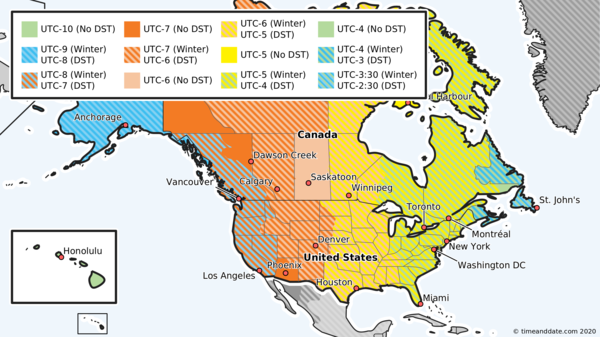Daylight Saving Time Ends in USA & Canada
In the United States, Canada, and Mexico's northern border cities, Daylight Saving Time (DST) ends on Sunday, November 7, 2021.


DST ends in the US and Canada on Sunday, November 7, 2021.
Β©³ΩΎ±³Ύ±π²Ή²Τ»ε»ε²Ή³Ω±π.³¦΄Η³Ύ
Clocks will be set back 1 hour from 02:00 (2 am) to 01:00 (1 am) in each time zone.
DST in the US starts again on Sunday, March 13, 2022.
As always, Europe will end DST a week before the US, on October 31, 2021.
Affects Most of the US
On November 7, the time will change in almost all of the United States.
Only the following areas do not change their clocks:
- Hawaii and most of Arizona.
- The US dependencies American Samoa, Guam, Puerto Rico, the Northern Marina Islands, the US Minor Outlying Islands, and the US Virgin Islands.
Daylight Saving Time in the US
Canada: DST Change
In Canada, clocks will change in almost all areas, except:
- Yukon
- Most of Saskatchewan
- Some locations in QuΓ©bec east of 63Β° west longitude (e.g., Blanc-Sablon)
- Southampton Island
- Some areas in British Columbia
Canadian clock change in detail
Up to US Congress to Change DST Law
According to the , 19 states have enacted legislation or passed regulations for permanent DST.
Congress must first pass a federal law that would allow states to observe DST year-round. The current law only allows states to forgo DST, but no states have received congressional approval to permanently stay on DST year-round.
Legislation in 2021:
- In March, Mississippi enacted , which would make DST the year-round standard time of the state.
- In April, the Governor signed to keep Georgia on DST permanently.
- In May, Montana enacted for year-round DST if Idaho, North Dakota, South Dakota, Utah, and Wyoming do the same.
- In May, the Governor signed that would put Alabama on year-round DST.
- Minnesota has made an amendment to provide for also known as DST, to be in effect year-round when approved by Congress.
Legislation in 2020:
- In February, the Utah Senate voted to approve . The bill would have Utah spring ahead and stay ahead permanently, but it requires action by at least four western states before taking effect.
- In February, the Governor of South Carolina signed to put the state on year-round DST.
- In March, Georgia adopted , urging the federal government to allow states to switch to permanent DST.
- In March, the Idaho Governor signed , making DST permanent in the state.
- In March, the Wyoming Governor signed , which aims to establish DST as the official time year-round. It needs to be approved by voters at the next general election.
- In June, the Governor of Louisiana signed to adopt Daylight Saving Time as the standard time.
Legislation in 2019:
- In December, the Governor of Delaware signed to keep the state permanently on DST. The bill requires that Pennsylvania, New Jersey, and Maryland each do the same.
- In June, Maine enacted that would keep the state on DST permanently.
- The Governor of Oregon signed for permanent DST in June 2019. The state will only implement the law if Washington and California approve their all-year DST policies.
- In May, the Governor of Washington signed in favor of permanent DST.
- In May, Tennessee governor Bill Lee signed , establishing DST as standard time.
- In December, Arkansas adopted , to allow the state to have permanent DST.
Legislation in 2018
- Florida's 2018 bill for permanent DST, dubbed the is awaiting congressional approval.
- 60% of Californians voted in favor of permanent DST in .
Mexico: Northern Border Cities Follow the US
Some northern Mexican border towns, such as Tijuana and Juarez (Ciudad JuΓ‘rez), end DST on November 7, with the US and Canada.
The rest of Mexico ends DST one week earlier on Sunday, October 31—on the same date as Europe's DST change.
The states of Sonora and Quintana Roo do not observe DST at all, so the clocks will not change there.
Other Countries and Territories
DST will also end on November 7 in Cuba, Bermuda, the Bahamas, Saint Pierre and Miquelon, and Thule Air Base in Greenland.
Upcoming DST changes worldwide
Set Clocks Back or Ahead?
One easy way to remember which way to set your clock is to keep in mind one of these sayings: βSpring forward, fall backβ or βSpring ahead, fall behind.β The clocks spring ahead (= losing 1 hour) in the spring when DST starts, and they fall back one hour (= gaining 1 hour) when DST ends in the fall.